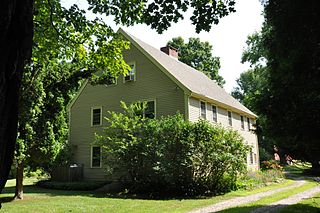
Kittery Point is a census-designated place (CDP) in the town of Kittery, York County, Maine, United States. First settled in 1623, Kittery Point traces its history to the first seafarers who colonized the shore of what became Massachusetts Bay Colony and later the State of Maine. Located beside the Atlantic Ocean, it is home to Fort McClary State Historic Site, and Fort Foster Park on Gerrish Island. Cutts Island is home to Seapoint Beach and the Brave Boat Harbor Division of the Rachel Carson National Wildlife Refuge.

Kittery is a town in York County, Maine, United States. Home to the Portsmouth Naval Shipyard on Seavey's Island, Kittery includes Badger's Island, the seaside district of Kittery Point, and part of the Isles of Shoals. The southernmost town in the state, it is a tourist destination known for its many outlet stores.

Sir William Pepperrell, 1st Baronet was a merchant and soldier in colonial Massachusetts. He is widely remembered for organizing, financing, and leading the 1745 expedition that captured the French fortress of Louisbourg during King George's War. He owned a number of enslaved people and was considered one of the richest people in America.

Fort McClary is a former defensive fortification of the United States military located along the southern coast at Kittery Point, Maine at the mouth of the Piscataqua River. It was used throughout the 19th century to protect approaches to the harbor of Portsmouth, New Hampshire and the Portsmouth Naval Shipyard in Kittery. The property and its surviving structures are now owned and operated by the State of Maine as Fort McClary State Historic Site, including a blockhouse dating from 1844.

The Lady Pepperrell House is an American historic house in Kittery Point, Maine. It stands on State Route 103, opposite the First Congregational Church and Parsonage. Built in 1760 by Lady Mary Pepperrell, widow of Sir William Pepperrell, the house is one of the finest examples of Georgian architecture in New England. Pepperrell was the only colonial American to be honored with a baronetcy, awarded by King George II for his leadership of the 1745 expedition against the French Fortress Louisbourg on Cape Breton Island. The house was designated a National Historic Landmark in 1960, but remains in private ownership, subject to preservation restrictions held by Historic New England.

The First Congregational Church and Parsonage is a historic church complex at 23 Pepperrell Road in the Kittery Point section of Kittery, Maine. Built in 1730 for a congregation first organized in 1653, the church is the oldest in Kittery, and one of the oldest in the state of Maine. It is accompanied by a parsonage house, built in 1729, and a small cemetery, established in 1733. The buildings were listed on the National Register of Historic Places in 1978; the cemetery was added to the listing in 1997.

The Bray House is a historic house at 100 Pepperell Road in Kittery Point, Maine, United States. It is one of the oldest surviving buildings in the state. Long thought to be a 17th-century structure, the architectural evidence indicates the home was probably not built before 1720. It was added to the National Register of Historic Places in 1979.

The Portsmouth Athenæum is an independent membership library, gallery, and museum in Portsmouth, New Hampshire, United States. It preserves and provides access to an extensive collection of manuscripts, rare books, photographs, artworks and artifacts, and digital collections related to local history and genealogy, in addition to a circulating library for its membership. As an intellectual center of the community, it sponsors exhibitions, concerts, lectures, and other educational and cultural programs. The building, dating to 1805, has been listed on the National Register of Historic Places since 1973.

The William Pepperrell House is a historic house at 94 Pepperrell Road in Kittery Point, Maine. Built about 1682 and later enlarged and restyled, it was at the time of its construction the grandest house in what is now the state of Maine. It is notable as the birthplace and home of Sir William Pepperrell (1696-1759) a leading businessman of the period whose greatest claim to fame was leading the 1745 Siege of Louisbourg during King George's War. The house was listed on the National Register of Historic Places in 1973.

The Saco Historic District encompasses the historic commercial and residential centers of Saco, Maine. Covering more than 100 acres (40 ha) of central Saco, it includes houses from the 18th through 20th centuries, and the main business district along Main Street. It was added to the National Register of Historic Places in 1998.

The Islesford Historical Museum and Blue Duck Ships' Store are related historical exhibits on Little Cranberry Island in Maine, USA, within the boundaries of Acadia National Park.

The Dennett Garrison is a historic First Period house at 100 Dennett Road in Kittery, Maine. With an estimated construction date of 1710, it is one of the oldest surviving buildings in the state of Maine. When listed on the National Register of Historic Places in 1978, it was still owned by descendants of its builder, John Dennett.

The William Dean Howells House is a historic house at 36 Pepperrell Road in Kittery Point, Maine. Built c. 1870, this house was for many years the summer residence of writer and editor William Dean Howells, best known as editor of Atlantic Monthly magazine. The house was listed on the National Register of Historic Places in 1979.

The Rankin Block is a historic commercial building at 600-610 Main Street in Rockland, Maine. Built in 1853, it is a fine example of a late Greek Revival commercial block. It was listed on the National Register of Historic Places in 1978. It currently houses a senior living facility.
John Street is a street running north to south through the Financial District of Lower Manhattan in New York City. It is one of the oldest streets in the city. Long associated with maritime activity, the street ran along Burling Slip. The slip was filled in around 1840, and the street widened. Besides a wharf, warehouse, and chandlery, the city's first permanent theatre, and the first Methodist congregation in North America were located on John Street. It was also the site of a well-known pre-Revolutionary clash between the Sons of Liberty and British soldiers, pre-dating the Boston Massacre by six weeks.

The ASN Co building is a heritage-listed building located at 1–5 Hickson Road, The Rocks, Sydney, New South Wales, Australia. Completed in 1885 and built in the Pre-Federation Anglo Dutch style under the direction of William Wardell and his associate, Walter Liberty Vernon, the building served as the principal offices and warehouse for the Australasian Steam Navigation Company until the company's merger in 1887, when the Government of New South Wales acquired the land used for ordinance facilities and later as government administration offices. Since 1989 the building has been owned by the Sydney Cove Redevelopment Authority and its successors. The building is currently used as an art gallery to display the works of Ken Done.

The Portsmouth Downtown Historic District encompasses the historic urban core of Portsmouth, New Hampshire. With a history dating to the 17th century, Portsmouth was New Hampshire's principal seaport and the center of its economy for many decades, and the architecture of its urban center is reflective of nearly four centuries of history. The district is roughly L-shaped, radiating from the downtown Market Square area to South Street in the south and Madison and Columbia streets in the west, with more than 1,200 historically significant buildings. It was listed on the National Register of Historic Places in 2017. The district includes 35 previous listings on the National Register, and five National Historic Landmarks.

The Campbell's Stores is a heritage-listed former warehouse building in the inner city Sydney suburb of The Rocks in the City of Sydney local government area of New South Wales, Australia. The Victorian Georgian building previously served as store houses and maritime bonded warehouses. It was built from 1850 to 1861. It faces Campbells Cove, an inlet in the north-west of Sydney Cove. In the 1970s, along with the general decline of commercial shipping activities in Sydney Cove, the building was converted for use as tourist-orientated restaurants and bars.

Grafton Bond Store is a heritage-listed former bond store and warehouse and now offices located at 60 Hickson Road, in the inner city Sydney suburb of Millers Point in the City of Sydney local government area of New South Wales, Australia. The 1881 sections of the building were designed by William Wardell. It was incorporated into the new Maritime Centre in the 1980s. It was added to the New South Wales State Heritage Register on 18 April 2000.




















